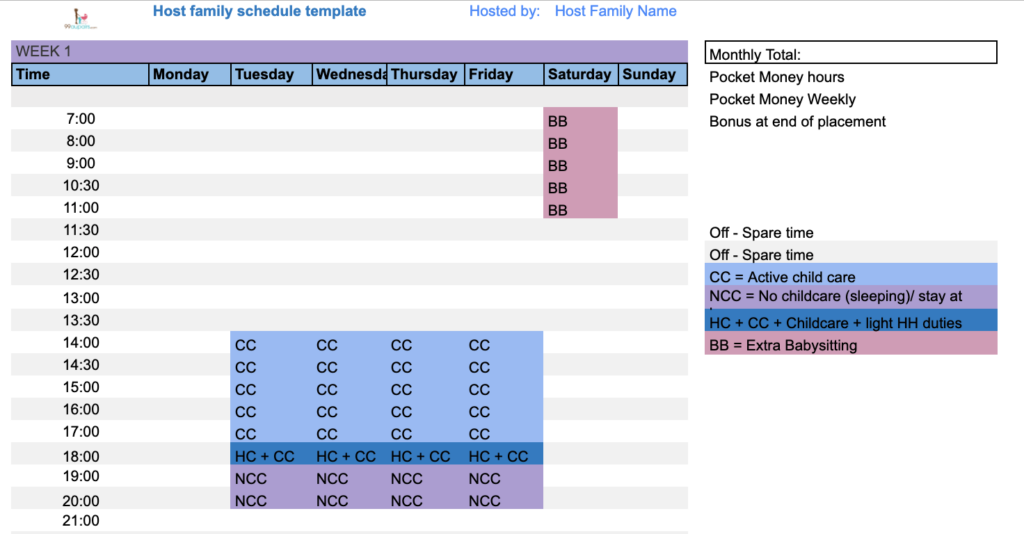Schedule Template
The best place to plan for your Aupair search is your schedule! If you know what you need and when you need it, then you can also start to think about what you want.
Creating a basic schedule
Write down every bit of activity that is critical, such as routines around toddlers. Does the toddler need a nappy change in the morning? Need to make food? Need to pack bags and lunches for the kindergarten? Need to sort and fold kids’ clothes, and put them away?
Once you have the tasks listed by day, for each child, then you can start looking at you and your partner’s schedules. When are you physically out of home? If you are working from home, what hours are you not available to ‘parent’ (nor look after the house)?

If you are staying at home, even part-time, to look after the children (and everything else) be clear, what are the things only you can do (or want to do)?
Do not make discounts on your schedule. The idea of habving an au pair to have
flexivle, in home help your children. You can be more flexible on your nice-to-have instead.
Work out what your schedule is like,what you want your Aupair to do, and what you want/need to do yourself. When do you need help with things like school drop-offs, during the “witching hour” (dinner/bath/bedtime routine) or if you need someone for more hours? When are you away from home? When are you available to care for the children? This will help you work out how many hours you need.
What type of Aupair is right for you based on your schedules?
By now you would have heard that there are live-in Aupairs, live-out Aupairs, part-time and full-time Aupairs. Aupairs that are already in the country – and can start immediately and others who are yet to get their visa and book their plane ticket, thus won’t be available for 1-6 months.
Here are a couple of examples:
If your work schedule requires an Aupair to start at 6:30 am because you are heading out the door to start your shift, a live-out Aupair may not be the logical solution. For me, if I need to go to work, I can’t afford to ‘worry’ about my help arriving on time. I love the fact that our kids are asleep and our Aupair can snuggle in her bed, and she is right there when the children wake up. Everyone (but me) is still in their pajamas and happy as Larry.
If you only need help for a few hours each day (i.e. after school care) it may be best to go with a demi-pair who works between 15-20 hours per week in exchange for board and food. This will also be easier on your out of pocket expenses while giving you the breathing space and a few more hours to focus on work/business if that’s what you need.
If you usually struggle with childcare when your partner is away or you need help during school holidays, you know that most dreaded times of the year for working parents – then you would probably go for a full-time Aupair – but agree to balance the hours between ‘light’ weeks when you require less support and heavy weeks when you need her full support. It could work really well if you plan far ahead, so your Aupair can also plan to travel or do other activities when she has a lot of spare time.
Many parents both work and require help with kids’ full time, often for more hours than a full-time Aupair can offer since Aupairs should not work more than 40 hours. In this case, you could always mix it up and have childcare fill the gaps. And your Aupair will be grateful to you that she has a breather during the week and will have more energy to look after your children the other days.
Now that you have an idea of what type of Aupair is right for you, you can head into the process of recruiting.
